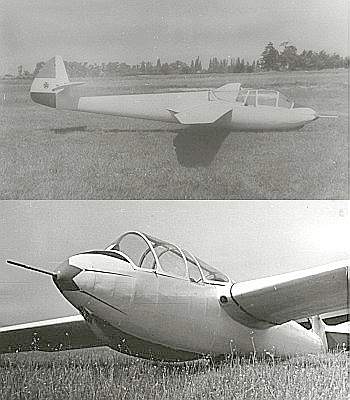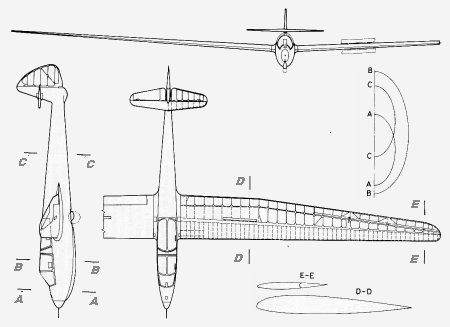HUNGARIAN
GLIDERS
1933-2000
| Type designation: |
M-30B |
| Name: |
Fergeteg |
| Designer: |
Lajos BENICZKY - István VÉRTES, Ferenc ZSEBŐ, Gábor JEREB, János CSERKUTI, András DOBOSSY, Győző SAJGÓ |
| Class: |
High performance |
| General arrangement: |
Shoulder wing, tandem seats, retractable wheel, traditional tail unit |
| Crew: |
2 |
| First flight: |
May 1952 |
| Manufacturer: |
Central Workshop of Hungarian Aeronautical Association, Dunakeszi |
| Number of built: |
1 |

Short history:
The Hungarian Aeronautical Association after having evaluated the results of the M-30 prototype's test flights as well as the experiments carried out at the wind tunnel of the Technical University of Budapest (BME), in the summer of 1951 gave an order for to redesign the type and to build a small number of the new glider. The aim of the redesign was to eliminate the vibration of the tail unit, to make the cockpit more comfortable, applying a new main spar, to improve the fittings of the wing connections, to enlarge the rudder's surface, to reduce control forces, and to simplify the control mechanisms. The flaps became the victims of the redesign as pilots of that time preferred flapless gliders.
The new glider, designated M-30B, had been built in the central workshop of the Hungarian Aeronautical Association at Dunakeszi, and the first flight was performed at May 1952.
Structure: All wooden
Wing:
The wing had one main spar, and a short fore and an aft secondary spar. The wing was covered in front of the main spar by plywood creating a strong torsional box structure. The wing was covered spanwise by plywood behind the main spar up to the outer end of the airbrakes, beyond that by fabric. The planform of the wing was double-trapezoid with the leading edge perpendicular to the fuselage main axis. The wing had no flaps and had one-piece ailerons. The fittings of the wing connection were riveted box-structures made of aluminium sheets. The ailerons were activated by a push-rod type mechanism, however the friction of the mechanism had been reduced compared to the M-30.
Fuselage:
The soulder-wing glider had a tandem seat arrangement. The cockpit was roomier than that of the prototype. The elliptical cross section fuselage was a plywood covered semi-monocoque structure. At the range of the seats the side of the fuselage was strengthened by double plywood covering. The fore and aft part of the two piece canopy opened separately sideways. The landing gear consisted of a rubber-ring suspended nose skid, a retractable wheel and an aft skid, which was a strengthened part of the fuselage keel. Both pilot's seats were fitted with an instrument panel.
Tail unit:
The tail unit had a traditional arrangement, with the elevator located above the fuselage on the vertical stabilizer. The elevator was of a semi-balanced type. The horizontal stabilizer's movement was half of the movement of the elevator. Its surface had been increased, and a more rigid connection was applied compared to the prototype. The elevator was activated by a push-rod type mechanism.
.jpg)

| Dimensions: |
| Wing: |
| Span, m: |
18,0 |
| Area, m2: |
18,96 |
| Aspect ratio: |
17,1 |
| Chord (root), m: |
1,4 |
| Chord (tip), m: |
0,55 |
| Airfoil (root), m: |
NACA 23012 |
| Airfoil (mid-span), m: |
NACA 23012 |
| Airfoil (tip), m: |
NACA 0009 |
| Dihedral, degree: |
3,0 |
| Sweep, degree: |
Central part: -0,23/Tapered parts: -1,9 |
| Washout: |
Aerodynamic and -2,0 degrees geometric |
| Aileron: |
| Span, m: |
4,12 |
| Mean chord, m: |
0,3 |
| Total area, m2: |
? |
| Balancing: |
Inner mass |
| Flap: |
| Type: |
None |
| Airbrakes: |
| Type: |
Göppingen |
| Position (upside/downside): |
u/d |
| Total area, m2: |
0,46 |
| Position, % of chord: |
0,458 |
| Horizontal stabilizer: |
| Span, m: |
2,55 |
| Area, m2: |
1,47 |
| Elevator: |
| Span, m: |
2,55 |
| Area, m2: |
0,7 |
| Airfoil: |
NACA 0009 |
| Balancing: |
Aerodynamic (50%) and inner mass |
| Trim: |
Yes |
| Vertical stabilizer and rudder: |
| Total area, m2: |
1,3 |
| Rudder area, m2: |
? |
| Balancing: |
None |
| Fuselage: |
| Length, m: |
7,95 |
| Width, m: |
0,6 |
| Height: |
1,07 |
| Cross section, m2: |
0,5 |
| Landing gear: |
| Type: |
Retractable |
| Wheel diameter, m: |
0,42 |
| Masses: |
| Wing, kg: |
? |
| Fuselage, kg: |
? |
| Tail unit, kg: |
? |
| Empty glider, kg: |
385 |
| Gross, kg: |
550 |
| Ballast, kg: |
None |
| Wing loading, kg/m2: |
29,0 |
| Speeds: |
| VNE, km/h: |
250 |
| Max. speed with open airbrakes, km/h: |
250 |
| Max. aerotow speed, km/h: |
130 |
| Max. winch speed, km/h: |
100 |
| Max. speed in rough air, km/h: |
? |
| Stall speed, km/h: |
75 |
| Performance: |
| Min. sink, m/s (at gliding speed, km/h): |
0,95/85 |
| Best L/D (at gliding speed, km/h): |
27/97 |
| Start methods: |
Winch, Aerotow |

Origin of data and 3-view drawing:
Jereb Gábor: Magyar vitorlázó repülőgépek, Műszaki Könyvkiadó, 1988, Budapest
(Gábor JEREB: Hungarian Gliders, Technical Publishing House, 1988, Budapest)
Gábor FEKECS E-mail: fekecs.gabor@t-online.hu

.jpg)
